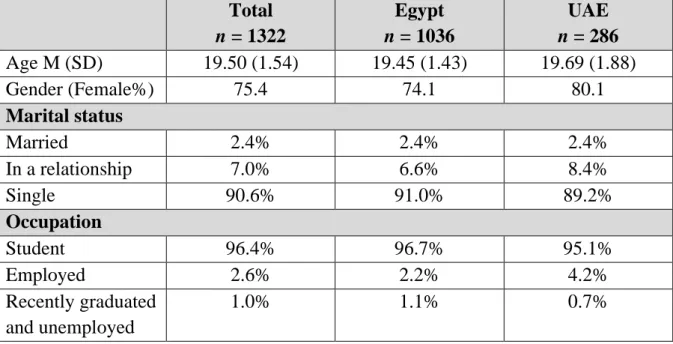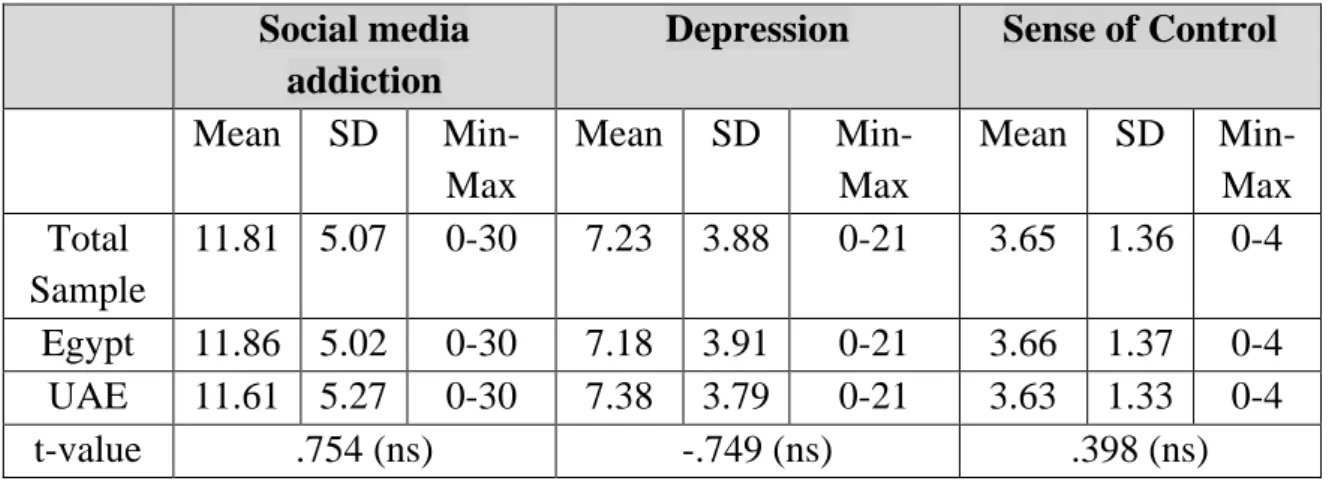SOCIAL MEDIA USE: INVESTIGATING THE PSYCHOMETRIC PROPERTIES OF THE ARAB BERGEN SOCIAL MEDIA ADDICTION SCALE AND THE MEDIATIONAL. Cover: The image illustrates the results of the study that found a link between feeling in control, symptoms of depression and addiction to social media. Specifically, the potential mediating role of control in the association between depression and social media addiction.
Introduction
- The Effects of Covid-19
- Psychological Burden
- The Effects of the Pandemic on Mental Health
- Social Media
- Mental Health in the Middle East
- Mental Health Stigma in the Middle East
- Social Media Use in the Middle East
- Bergen Social Media Addiction Scale
- Research Aims
- Hypotheses
Another analysis by Huang (2022), examined the effects of problematic social media use on well-being and. This is particularly worrying as there is still a gap in research around the effects of social media on mental health (Vally & Alowais, 2021). The Bergen Social Media Addiction Scale (BSMAS) was adapted from the Bergen Facebook Addiction Scale (BFAS) when researchers highlighted the limitations of the BFAS as a measure that specifically focuses on Facebook (Andreassen et al., 2012).
A study conducted in Hungary by Bányai et al. 2017) aimed to identify groups at risk for alcohol and drug use with social media addiction as an indicator. Another study by Alimoradi et al. 2019) sought to investigate the mediating effect of intimacy and perceived social support on social media addiction and sexual distress. BSMAS assisted Alimoradi et al. 2019) to effectively analyze and provide an overview of the need for the use of social media as a factor in sexual counseling.
The BSMAS has also been translated and found to be an effective measure for assessing social media addiction among heterogeneous subsamples in Hong-Kong and Taiwan (Brailovskaia & Margraf, 2022; Leung et al., 2020). Specifically, the potential mediating role of sense of control in the relationship between depression and social media addiction. Sense of control will mediate the relationship between social media addiction and symptoms of depression (3).
A hypothesized mediating process between sense of control, depressive symptoms, and social media addiction (Figure 1).
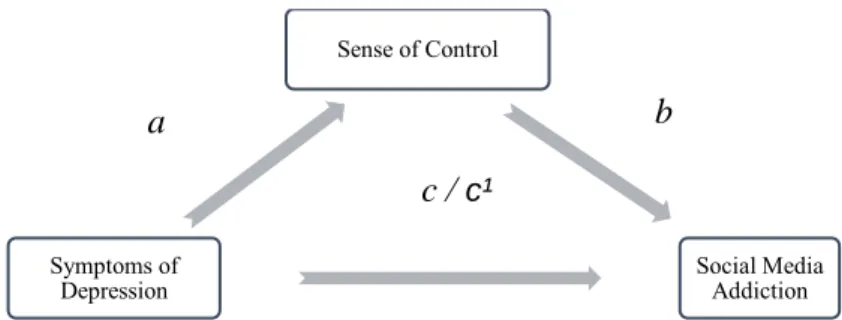
Method
- Participants
- Procedure
- Ethics
- Assessment measures
- Bergen Social Media Addiction Scale (Abbreviated BSMAS)
- Depression Anxiety Stress Scales 21 (DASS-21)
- Sense of Control
- Data analysis
- Descriptive and Correlational Analyses
- Psychometric investigation
- Mediation analysis
For this study, items from the BSMAS were translated into Arabic using the back-translation method proposed by Brislin (1970). Both versions were then reviewed and compared for equivalence, such as cultural appropriateness, and discrepancies, resulting in a consensually agreed Arabic version of the BSMAS. In the current study, internal consistency for the measure was good (α = 0.80). See Appendix A for a copy of the BSMAS).
The DASS-21 is a condensed version of the original DASS-21 which included 42 items measuring three dimensions of negative emotional states, namely depression. The current study specifically used the depression subscale of the Validated Arabic Depression Stress Scale (DASS-21). The Arabic version of DASS-21 has been found to have high construct, convergent and discriminant validity (Vally & . Alowais, 2021).
Next, each of the six items comprising the BSMAS was examined for normal data distribution by generating skewness and kurtosis values. The convergent validity of the BSMAS was assessed by calculating the Pearson correlation between the BSMAS and.
Results
Sample descriptive statistics
Psychometric investigation of the Arabic Translated BSMAS
- Internal consistency
- Factorial Validity
- Convergent validity
CFA with maximum likelihood estimation was conducted to investigate the unidimensionality of the Arabic translated BSMAS. As can be seen in Table 2, the following thresholds were adopted for the interpretation of the resulting result: insignificant value of χ2 (p > 0.05); χ2/df value < 3.0; root mean square error of approximation (RMSEA) and standardized root mean square error of residual (SRMR) < 0.08; comparative fit index (CFI) and Tucker-Lewis index (TLI) > 0.95; and goodness-of-fit index (GFI) and adjusted goodness-of-fit index (AGFI) > 0.90. According to Fornell and Larcker (1981), the convergent validity of an instrument can be determined by examining two variables, the average variance extracted (AVE) of the latent variable and the composite reliability (CR) of the measure.
Convergent validity can be considered sufficient when the AVE value is ≥ 0.5 and the CR value is ≥ 0.7. The calculated AVE value was below the desired threshold (0.46); However, the CR value (.83) was satisfactory. To further test the convergent validity of the Arabic BSMAS, a Pearson correlation was calculated with the depression subscale of the DASS-21.
The magnitude of the correlation value was large and highly significant (r = .47, p < .001), suggesting an association between these two instruments as a measure of psychopathology. The results of these statistical tests support the convergent validity of the newly translated Arabic BSMAS.
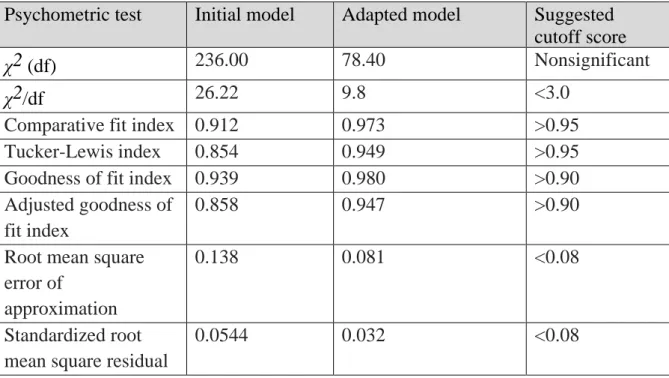
Mediation results
- Descriptive and correlational results
- Results of the mediation process
As indicated by Table 4, Pearson's correlation analyzes indicated statistically significant associations between depression and sense of control (r = -.113, p < .01); and between social media addiction and depression (r = .465, p < .001), however, there was not a significant relationship between social media addiction and sense of control (r = .007, p > .05). Analyzes of the prespecified mediation model, as illustrated in Figure 2, indicated that symptoms of depression were significantly related to sense of control reflecting path a of the model (β = -.04, SE = .01, t = -4.13 , p < .001). Finally, the direct effect of depression on SMA was also significant indicating that sense of control significantly mediated the relationship between the predictor and outcome variables (β = .62, SE = .03, 95%CI .55-.68).
25 Table 5: Estimated coefficients for the tested mediation model (model 2), total sample and for each country (outcome: addiction to social media). SMA = social media addiction, SE = standard error, 95% CI = confidence interval calculated bootstrapping at 10,000 samples, c = ratio between social media addiction and depression, c' = ratio between social media addiction and.
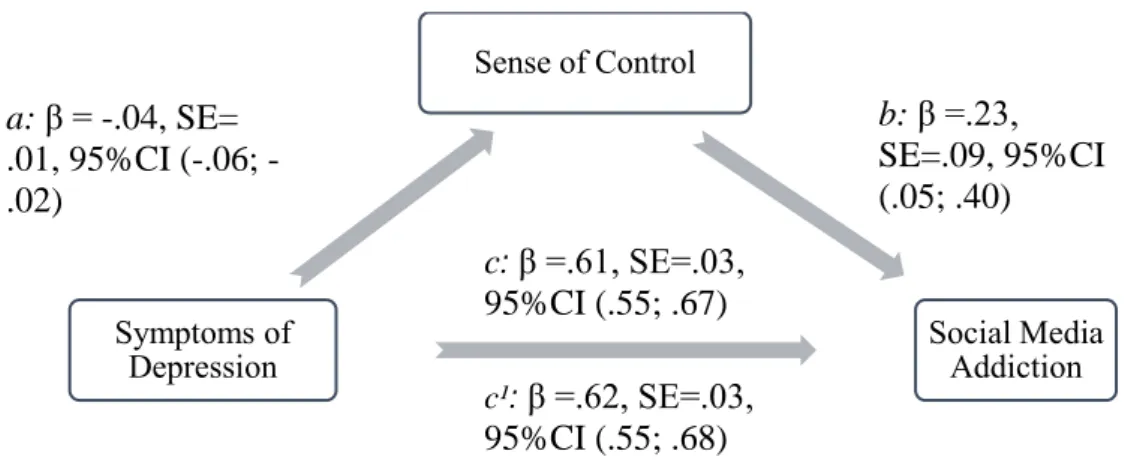
Discussion
Discussion of Results
Due to the need for more research on the psychological effects of social media use, the second aim of the study was to investigate the relationship between depression, social media addiction and sense of control. Specifically, sense of control was investigated as a potential mediator between social media addiction and depression. Correlation results from the Arabic translated BSMAS indicated that students at the specific universities generally did not exhibit significant social media addiction characteristics.
The results indicate that there is a strong relationship between variables with some discrepancy between social media addiction and control. The model outcome concluded that feelings of control influenced social media addiction (Supporting Hypothesis 2c), that symptoms of depression influenced feelings of control (Supporting Hypothesis 2b), and that symptoms of depression significantly influenced social media addiction (Supporting Hypothesis 2a). Finally, the direct effect of depression on social media addiction was also significant, indicating that sense of control significantly mediated the relationship between the predictor (depression) and the outcome variable (social media addiction), thus supporting hypothesis 3.
In contrast to the correlation results, the mediation model found a relationship between the variables and proved that sense of control mediates the relationship between social media addiction and depression. This can be understood as the relationship between sense of control and social media addiction may not be very significant, however, there is an associated/mediating effect.
Implications
By raising awareness about the potential link between depression and social media/social media addiction, practitioners can support these individuals by reducing overexposure, developing adequate skills, and further exploring the underlying contributing factors. It has also been found that the sense of control is associated with depression and social media addiction, acting as a mediator between these variables. According to Hussain and Griffiths (2018), addiction and sense of control are strongly correlated with addiction being based on a lack of control over substance use or engaging in activities that are harmful to oneself or others.
This study has provided mental health practitioners with valuable insight into providing and developing effective intervention strategies for individuals associated with social media addiction. The study supports the claim that promoting a sense of control among individuals, especially among young people, can potentially alleviate symptoms of depression and the underlying drives that manifest as social media addiction. The significance of this study at a societal level is that it highlights the danger of excessive social media use, the potential for social media addiction and the associated risk of poor mental health, specifically depression.
The insight presented by this study can support leaders within areas of influence to support positive mental health by raising concerns about the potential dangers of excessive social media use, particularly among young people in areas such as schools and university campuses. . Awareness campaigns, mental health services on campuses and parent information sessions among this target group can be of great benefit to minimize risk and promote mental health.
Limitations & Recommendations
The implication of this study is limited by a narrow sample, which is mainly due to the convenience sampling method used. Increasing the diversity of the sample as well as the sample size would greatly aid in a holistic understanding of the effects of social media on the larger population. Research on mental health in Egypt remains sparse, and as a large part of this study's sample, it is worth noting that additional trends related to addiction and depression may be.
The psychological effects of social media on individuals also remain understudied (Al-Menayes, 2015; Duradoni et al., 2020; Lee et al., 2022). This study sought to expand on the research surrounding excessive social media use by examining the relationship between social media addiction, depression and sense of control. The relationship between social media addiction and sense of control indicated a non-significant link within the correlation results and a significant link within the mediation study.
A reliable and valid psychometric measure is needed to further support the research surrounding social media addiction in the Middle Eastern region. The Arabic translated version of the BSMAS was useful in this study, but there were inconsistencies in some of its validity and reliability results highlighting a need to further investigate this measure as a valid assessment measure that accurately assesses social media addiction.
Conclusion
Mental health during COVID-19 lockdown in India: Role of psychological capital and internal locus of control. Validation of the Bergen Social Media Addiction Scale (BSMAS) and examination of protective factors in nine countries. Prevalence of social media addiction across 32 nations: Meta-analysis with subgroup analysis of classification schemes and cultural values.
Social media use and mental health during the COVID-19 pandemic in young adults: a meta-analysis of 14 cross-sectional studies. Prevalence of mental health problems in children and adolescents during the COVID-19 pandemic: a systematic review and meta-analysis. Social network addiction, attachment style and validation of the Italian version of the Bergen Social Media Addiction Scale.
Mental health before and during the COVID-19 pandemic: A longitudinal probability sample survey of the UK population. Doomscrolling during COVID-19: The negative association between daily social and traditional media consumption and mental health symptoms during the COVID-19 pandemic. The psychological impact of the COVID-19 pandemic on adults and children in the United Arab Emirates: A nationwide cross-sectional study.
The association between COVID-19-related psychological burden and addictive social media use: Testing the mediating role of affect anxiety.
